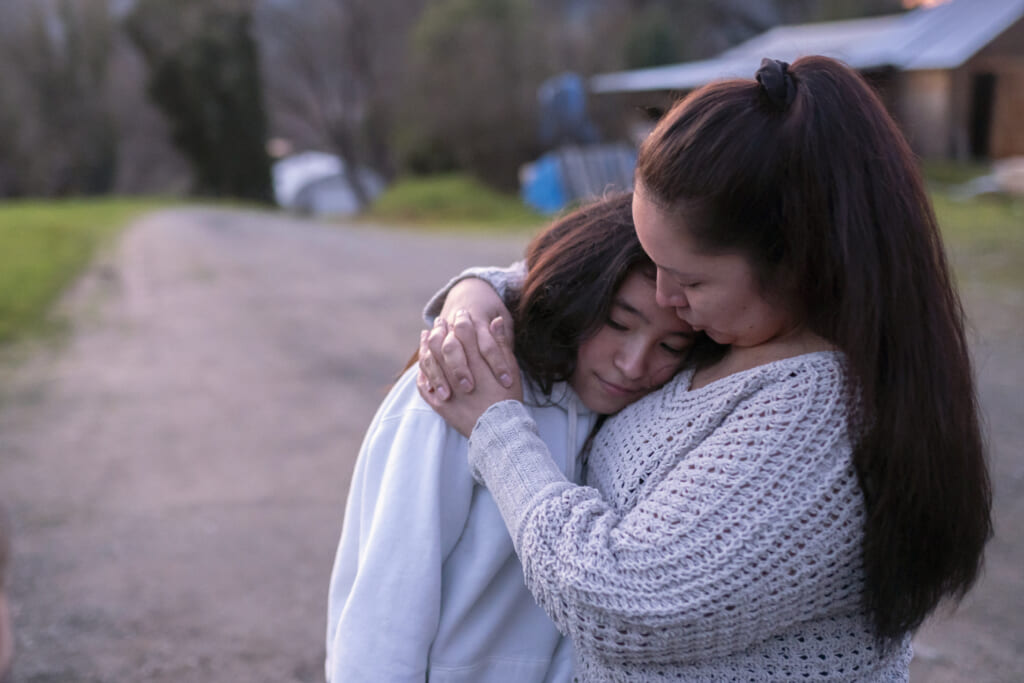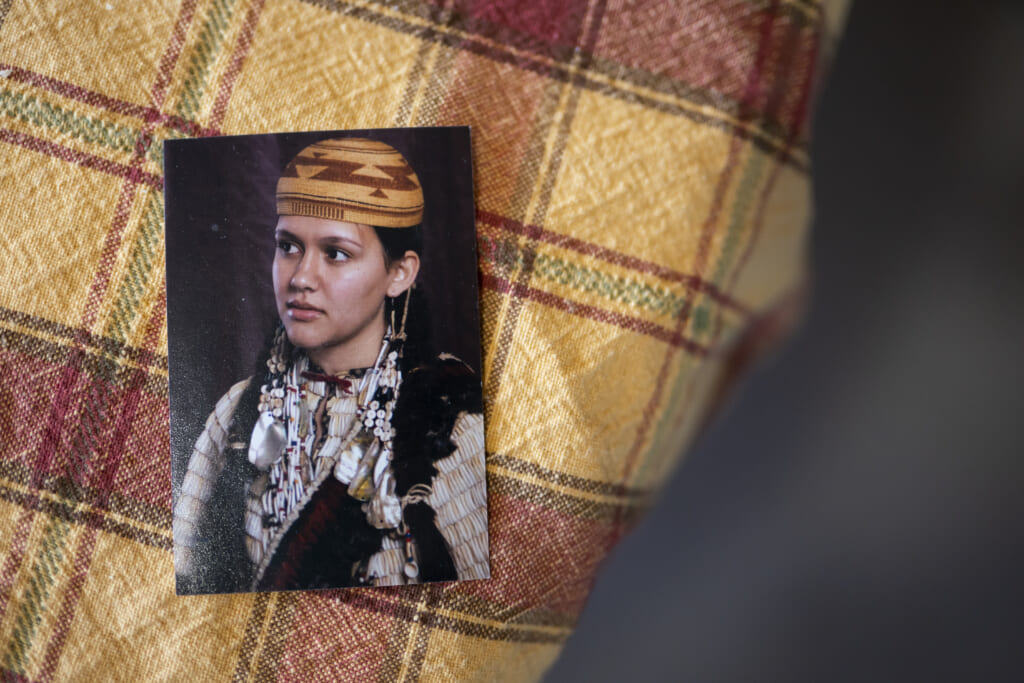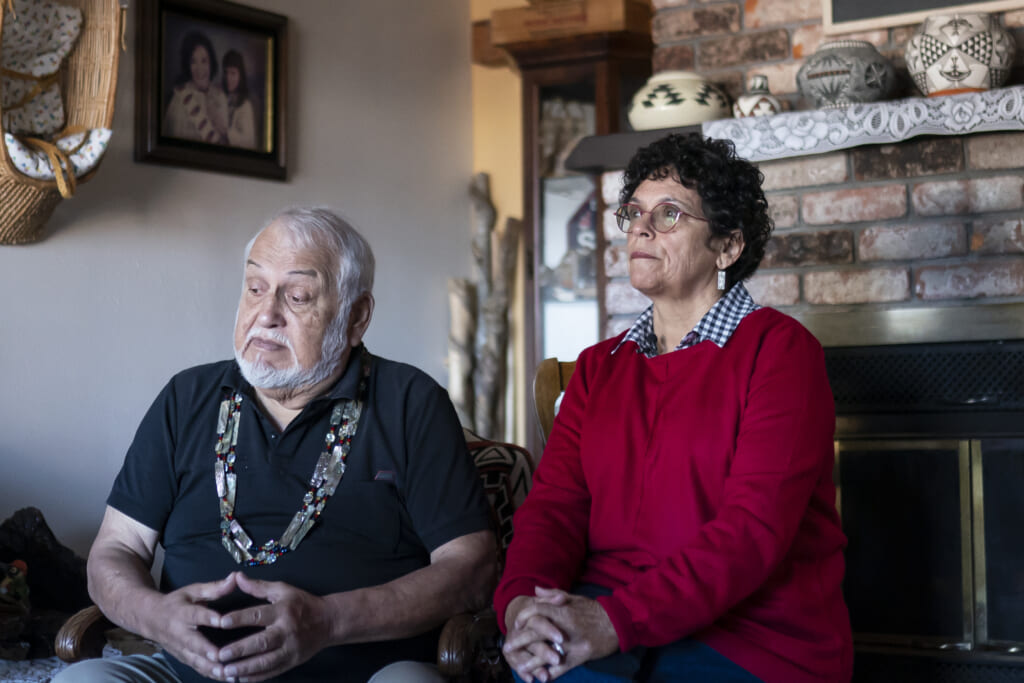Young mother among many missing Native American women
At least five young women associated with the Yurok reservation have gone missing in the last 18 months
The young mother had behaved erratically for months, hitchhiking and wandering naked through two Native American reservations and a small town clustered along Northern California’s rugged Lost Coast.
But things escalated when Emmilee Risling was charged with arson for igniting a fire in a cemetery. Her family hoped the case would force her into mental health and addiction services. Instead, she was released over the pleas of loved ones and a tribal police chief.
The 33-year-old college graduate — an accomplished traditional dancer with ancestry from three area tribes — was last seen soon after, walking across a bridge near a place marked End of Road, a far corner of the Yurok Reservation where the rutted pavement dissolves into thick woods.

Her disappearance is one of five instances in the past 18 months where Indigenous women have gone missing or been killed in this isolated expanse of Pacific coastline between San Francisco and Oregon, a region where the Yurok, Hupa, Karuk, Tolowa and Wiyot people have coexisted for millennia. Two other women died from what authorities say were overdoses despite relatives’ questions about severe bruises.
The crisis has spurred the Yurok Tribe to issue an emergency declaration and brought increased urgency to efforts to build California’s first database of such cases and regain sovereignty over key services.
“I came to this issue as both a researcher and a learner, but just in this last year, I knew three of the women who have gone missing or were murdered — and we shared so much in common,” said Blythe George, a Yurok tribal member who consults on a project documenting the problem. “You can’t help but see yourself in those people.”
The recent cases spotlight an epidemic that is difficult to quantify but has long disproportionately plagued Native Americans.
A 2021 report by a government watchdog found the true number of missing and murdered Indigenous women is unknown due to reporting problems, distrust of law enforcement and jurisdictional conflicts. But Native women face murder rates almost three times those of white women overall — and up to 10 times the national average in certain locations, according to a 2021 summary of the existing research by the National Congress of American Indians. More than 80% have experienced violence.
In this area peppered with illegal marijuana farms and defined by wilderness, almost everyone knows someone who has vanished.
Missing person posters flutter from gas station doors and road signs. Even the tribal police chief isn’t untouched: He took in the daughter of one missing woman, and Emmilee — an enrolled Hoopa Valley tribal member with Yurok and Karuk blood — babysat his children.
In California alone, the Yurok Tribe and the Sovereign Bodies Institute, an Indigenous-run research and advocacy group, uncovered 18 cases of missing or slain Native American women in roughly the past year — a number they consider a vast undercount. An estimated 62% of those cases are not listed in state or federal databases for missing persons.
Hupa citizen Brandice Davis attended school with the daughters of a woman who disappeared in 1991 and now has daughters of her own, ages 9 and 13.
“Here, we’re all related, in a sense,” she said of the place where many families are connected by marriage or community ties.
She cautions her daughters about what it means to be female, Native American and growing up on a reservation: “You’re a statistic. But we have to keep going. We have to show people we’re still here.”
Like countless cases involving Indigenous women, Emmilee’s disappearance has gotten no attention from the outside world.
But many here see in her story the ugly intersection of generations of trauma inflicted on Native Americans by their white colonizers, the marginalization of Native peoples and tribal law enforcement’s lack of authority over many crimes committed on their land.
Virtually all of the area’s Indigenous residents, including Emmilee, have ancestors who were shipped to boarding schools as children and forced to give up their language and culture as part of a federal assimilation campaign. Further back, Yurok people spent years away from home as indentured servants for colonizers, said Judge Abby Abinanti, the tribe’s chief judge.
The trauma caused by those removals echoes among the Yurok in the form of drug abuse and domestic violence, which trickles down to the youth, she said. About 110 Yurok children are in foster care.
“You say, ‘OK, how did we get to this situation where we’re losing our children?'” said Abinanti. “There were big gaps in knowledge, including parenting, and generationally those play out.”
An analysis of cases by the Yurok and Sovereign Bodies found most of the region’s missing women had either been in foster care themselves or had children taken from them by the state. An analysis of jail bookings also showed Yurok citizens in the two-county region are 11 times more likely to go to jail in a given year — and half those arrested are female, usually for low-level crimes. That’s an arrest rate for Yurok women roughly five times the rate of female incarcerations nationwide, said George, the University of California, Merced sociologist consulting with the tribe.

The Yurok run a tribal wellness court for addiction and operate one of the country’s only state-certified tribal domestic violence perpetrator programs. They also recently hired a tribal prosecutor, another step toward building an Indigenous justice system that would ultimately handle all but the most serious felonies.
The Yurok also are working to reclaim supervision over foster care and hope to transfer their first foster family from state court within months, said Jessica Carter, the Yurok Tribal Court director. A tribal-run guardianship court follows another 50 children who live with relatives.
The long-term plan — mostly funded by grants — is a massive undertaking that will take years to accomplish, but the Yurok see regaining sovereignty over these systems as the only way to end the cycle of loss that’s taken the greatest toll on their women.
“If we are successful, we can use that as a gift to other tribes to say, ‘Here’s the steps we took,'” said Rosemary Deck, the newly hired tribal prosecutor. “‘You can take this as a blueprint and assert your own sovereignty.'”
Emmilee was born into a prominent Native family, and a bright future beckoned.
Starting at a young age, she was groomed to one day lead the intricate dances that knit the modern-day people to generations of tradition nearly broken by colonization. Her family, a “dance family,” has the rare distinction of owning enough regalia that it can outfit the brush, jump and flower dances without borrowing a single piece.
At 15, Emmilee paraded down the National Mall with other tribal members at the opening of the Smithsonian’s National Museum of the American Indian. The Washington Post published a front-page photo of her in a Karuk dress of dried bear grass, a woven basket cap and a white leather sash adorned with Pileated woodpecker scalps.
The straight-A student earned a scholarship to the University of Oregon, where she helped lead a prominent Native students’ group. Her success, however, was darkened by the first sign of trouble: an abusive relationship with a Native man whom, her mother believes, she felt she could save through her positive influence.
Later, Emmilee dated another man, became pregnant and returned home to have the baby before finishing her degree.
She then worked with disadvantaged Native families and eventually got accepted into a master’s program. She helped coach her son’s T-ball team and signed him up for swim lessons.
But over time, her family says, they noticed changes.
Emmilee was uncharacteristically tardy for work and grew more combative. She often dropped off her son with family, and she fell in with another abusive boyfriend. Her son was removed from her care when he was 5; a girl born in 2020 was taken away as a newborn as Emmilee’s behavior deteriorated.
Her parents remain bewildered by her rapid decline and think she developed a mental illness — possibly postpartum psychosis — compounded by drugs and the trauma of domestic abuse. At first, she would see a doctor or therapist at her family’s insistence but eventually rebuffed all help.
After her daughter’s birth, Emmilee spiraled rapidly, “like a light switched,” and she began to let go of the Native identity that had been her defining force, said her sister, Mary.
“That was her life, and when you let that go, when you don’t have your kids … what are you?” she said.
In the months before she vanished, Emmilee was frequently seen walking naked in public, talking to herself. She was picked up many times by sheriff’s deputies and tribal police but never charged.
The only in-patient psychiatric facility within 300 miles (480 kilometers) was always too full to admit her. Once, she was taken to the emergency room and fled barefoot in her hospital gown.
“People tended to look the other way. They didn’t really help her. In less than 24 hours, she was just back on the street, literally on the street,” said Judy Risling, her mother. “There were just no services for her.”
In September, Emmilee was arrested after she was found dancing around a small fire in the Hoopa Valley Reservation cemetery.

Then-Hoopa Valley Tribal Police Chief Bob Kane appeared in a Humboldt County court by video and explained her repeated police contacts and mental health problems. Emmilee mumbled during the hearing then shouted out that she didn’t set the fire.
She was released with an order to appear again in 12 days after her public defender argued she had no criminal convictions and the court couldn’t hold her on the basis of her mental health.
Then, Emmilee disappeared.
“We had predicted that something like this may … happen in the future,” said Kane. “And you know, now we’re here.”
If Emmilee fell through the cracks before she went missing, she has become even more invisible in her absence.
One of the biggest hurdles in Indian Country once a woman is reported missing is unraveling a confusing jumble of federal, state, local and tribal agencies that must coordinate. Poor communication and oversights can result in overlooked evidence or delayed investigations.
The problem is more acute in rural regions like the one where Emmilee disappeared, said Abigail Echo-Hawk, citizen of the Pawnee Nation of Oklahoma and director of the Urban Indian Health Institute in Seattle.
“Particularly in reservations and in village areas, there is a maze of jurisdictions, of policies, of procedures of who investigates what,” she said.
Moreover, many cases aren’t logged in federal missing persons databases, and medical examiners sometimes misclassify Native women as white or Asian, said Gretta Goodwin, of the U.S. Government Accountability Office’s homeland security and justice team.
Recent efforts at the state and federal level seek to address what advocates say have been decades of neglect regarding missing and murdered Indigenous women.
Former President Donald Trump signed a bill that required federal, state, tribal and local law enforcement agencies to create or update their protocols for handling such cases. And in November, President Joe Biden signed an executive order to set up guidelines between the federal government and tribal police that would help track, solve and prevent crimes against all Native Americans.
A number of states, including California, Oregon, Washington and Arizona, are also taking on the crisis with greater funding to tribes, studies of the problem or proposals to create Amber Alert-style notifications.
Emmilee’s case illustrates some of the challenges. She was a citizen of the Hoopa Valley Tribe and was arrested on its reservation, but she is presumed missing on the neighboring Yurok Tribe’s reservation.
The Yurok police are in charge of the missing persons probe, but the Humboldt County Sheriff’s Office will decide when to declare the case cold, which could trigger federal help.
The remote terrain where Emmilee was last seen — two hours from the nearest town — created hurdles common on reservations.
Law enforcement determined there wasn’t enough information to launch a formal search and rescue operation in such a vast, mountainous area. The Yurok police opted to forgo their own search because of liability concerns and a lack of training, said Yurok Tribal Police Chief Greg O’Rourke.
Instead, Yurok and Hoopa Valley police and sheriff’s deputies plied the rain-swollen Klamath River by boat and drove back roads.
Emmilee’s father, Gary Risling, says the sheriff’s office failed to act on anonymous tips, was slow to follow up on possible sightings and focused more resources on other missing person’s cases, including a wayward hunter and a kayaker lost at sea.
“I don’t want to seem like I’m picking on them, but that effort is sure not put forward when it becomes a missing Indian woman,” he said.
Humboldt County Sheriff William Honsal declined interview requests, saying the Yurok are in charge and there are no signs of foul play. O’Rourke said the tips aren’t enough for a search warrant and there’s nothing further the tribal police can do.
The police chief, who knew Emmilee well, says his work is frequently stymied by a broader system that discounts tribal sovereignty.
“The role of police is protect the vulnerable. As tribal police, we’re doing that in a system that’s broken,” he said. “I think that is the reason that Native women get all but dismissed.”
Emmilee’s family, meanwhile, is struggling to shield her children, now 10 and almost 2, from the trauma of their mother’s disappearance — trauma they worry could trigger another generational cycle of loss.
The boy has been having nightmares and recently spoke everyone’s worst fear.
“It’s real difficult when you deal with the grandkids, and the grandkid says, ‘Grandpa, can you take me down the river and can we look for my mama?’ What do you tell him? ‘We’re looking, we’re looking every day,'” said Gary Risling, choking back tears.
“And then he says, ‘What happens if we can’t find her?'”
Associated Press video journalist Manuel Valdes in Seattle contributed to this report.
Have you subscribed to the Grio podcasts, Dear Culture or Acting Up? Download our newest episodes now! TheGrio is now on Apple TV, Amazon Fire, and Roku. Download theGrio today!
More About:News





